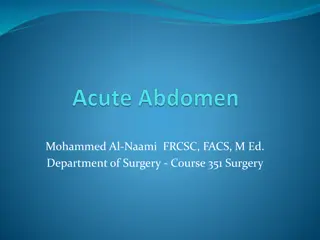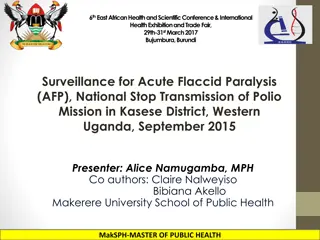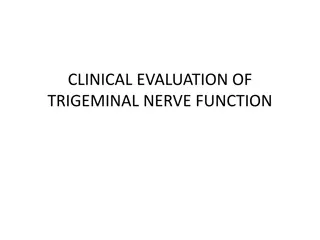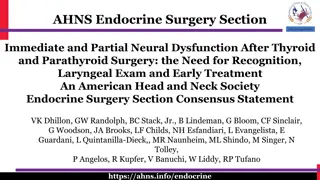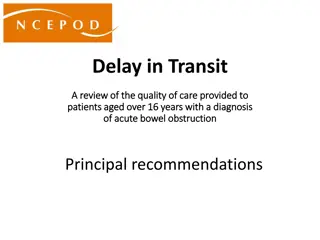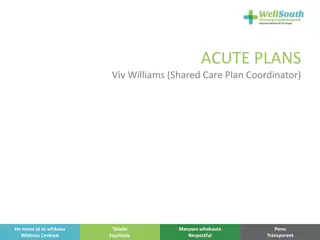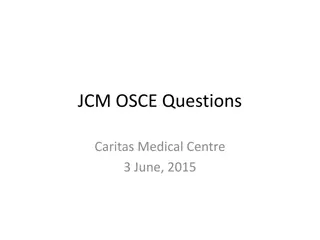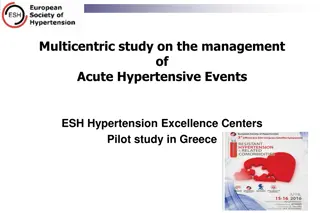Approach to Acute Flaccid Paralysis in Children: Evaluation and Management
Acute muscular weakness in children is a neurological emergency defined by sudden onset muscle weakness or paralysis in less than 5 days. When evaluating a child with acute flaccid paralysis, consider factors like onset rhythm, associated symptoms, and past medical history. A thorough physical and neurological exam is crucial to identify potential causes such as upper motor neuron disorders, lower motor neuron diseases, and various inflammatory conditions affecting the central nervous system. Understanding the clinical presentation and conducting a comprehensive assessment are vital in the effective management of acute flaccid paralysis in pediatric patients.
Download Presentation

Please find below an Image/Link to download the presentation.
The content on the website is provided AS IS for your information and personal use only. It may not be sold, licensed, or shared on other websites without obtaining consent from the author. Download presentation by click this link. If you encounter any issues during the download, it is possible that the publisher has removed the file from their server.
E N D
Presentation Transcript
Approach to a Child with Acute Flaccid Paralysis Dr. Soroor Inaloo Pediatric Neurologist Shiraz University of Medical Science 2021
Acute Muscular Weakness in children Acute Muscle weakness is a major neurological emergency in pediatric It is defined by muscle weakness or acute flaccid paralysis onset less than 5 days (WHO definition)
Pseudo paralysis :musculoskeletal pain ,conversion True weakness : upper motor & lower motor Upper motor : cortex ,white matter , basal ganglia ,thalamus, cerebellum Lower motor :motor neuron in brain stem ,ventral horn of the spinal cord ,nerve root, peripheral nerve ,neuromuscular junction ,muscle
Clinical history Onset Rhythm- abrupt rapidly or slowly progressing, fluctuation or remitting recurring Weakness ascending ordescending Weakness improved with restand worsen with activity Associated symptom (fever, headache, diarrhea) Concomitant sensorysymptoms, (pain, tenderness, dysesthesias, numbness) Change in urination and bowel habits Developmental history
History continue Mental status change Developmental history History of seizure History of trauma History of vaccination Drug and toxin exposure Family history Recent specific diet (shellfish ,canned food ) Contact with pets and otheranimal Psychosocial history recent stress, interaction with peers, death
Physical and neurological exam Vital signs Head circumferences Growth parameter Body symmetry Nuchal rigidity and meningeal signs Mental status Cardiovascular and respiratory systems and abdominal exam Cranial nerve exam Motor Sensory Coordination Gait DTR and plantar reflex Sign of chronic muscle disease (muscle atrophy ,fasciculation ,gowers sign)
Causes of acute muscular weakness Upper motor Neuron Encephalitis Encephalomyelitis Multiple sclerosis Brainstem encephalitis Transverse myelopathy Postinfectious myelitis (demyelinating) Neuromyelitis optica (Devic s disease) Motor Unit Lower motor neuron Wildtype / Vaccinal polio virus EV 71 ,West Nile Virus, EV 68 Peripheral nerve Guillain Barr syndrome and variants Porphyric neuropathy Diphtheritic neuropathy Heavy-metal poisoning Paralytic shellfish poisoning Tick paralysis
Cause continue Neuromuscular junction Presynaptic Botulism Spider venom (latrodectus mactans) Synaptic Organophosphate poisoning Post synaptic Autoimmune myasthenia gravis: Myasthenic crisis Muscle Acute infectious myositis Polymyositis / dermatomyositis Rhabdomyolysis (metabolic myopathies) Periodic Paralysis Critical Illness myopathy Psychogenic Psychogenic paralysis
Upper motor neuron signs Change in mental status and consciousness Seizure Hemiplegia DTR normal or hyper Plantar reflex (up) Clonus Cranial nerve involvement
Lower motor neuron Bilateral and or symmetrical weakness DTR normal or hypo Plantar reflex normal or mute Mental status and consciousness normal
Weakness Lower motor DTR or absent Flaccidity Planter reflex: down or mute Planter reflex : up Clonus Fasciculation Atrophy or hypertrophy Other CNS problem Upper motor DTR NL or hyper flaccidity in acute phase Clonus Fasciculation NL or slight atrophy Other CNS problem
Most common cause Gillian barre syndrome Transverse myelitis ADEM Infections myelitis Stroke Myasthenia gravis Myositis
Case A 7 y/o boy present with inability to walk since 2 days ago P/E: alert, cranial nerve normal ,powerupper 5/5 Lowerproximal 1/5 distal 2/5 DTR : 0 Plantarreflex : mute No sensory level no sphincterdysfunction Bestdiagnosis ?
Guillain barre syndrome Autoimmune disease Acute onset rapidly progressive symmetric ascending paralysis and areflexia Prior infection (URI ,GE ) in 50 to 70% post vaccination less than 10 % (30 days) Incidence 0.5 -2 case per 100,000 Multiple variant (AIDP 85 to 90% , AMAN, AMSAN, Miller Fisher )
Diagnosis &Treatment of GBS Clinical feature EMG -NCV : demyelinating or axonal injury CSF analysis protein increased > 2 time normal limits normal sugar , cell <10 lymph Spinal cord MRI :contrast enhancement Treatment : IVIG ,plasmapheresis
Case A 13 y/o girl present with sudden weakness in both lower extremities positive history of back pain and urinary retention P/E: alert ,conscious ,crania nerve intact ,DTR :0 Motor power upper 2/5 lower 3/5 sensory level :below umbilicus , anal tone :decreased Best diagnosis? First work up ?
Transverse myelitis (ATM) ATM accounts for one fifth of acquired demyelinating disease Incidence in children: 2 in 1,000,000 Male to female : 1.1 to 1.6 Two peak 0-2 y and 5-17 y Two third have prodromal infection within in past 30 d Acute onset bilateral paraplegia or tetraplegia ,decreased or loss of sensation ,sphincter dysfunction Course has 3 phase :acute (2-7 days),plateau(1-26 days), and recovery (month to years)
Diagnosis &Treatment of ATM Clinical course Exclude other cause of paralysis CSF pleocytosis ,elevated IgG Abnormal spinal cord MRI Treatment :pulse methyl prednisolone .IVIG ,plasmapheresis ,rituximab
Acute dissemination encephalomyelitis (ADEM) Is inflammatory ,demyelinating disease Typically occurs within 2 to 4 weeks following a viral infection or less commonlyvaccination with multifocal encephalopathy, fever headache ,vomiting, seizure, meningeal sign, visual loss, cranial nerve palsies, mental statuschange (lethargy tocoma) Present neurologic deficits, Mean age 5.7 years male to female 2.3 : 1
Diagnosis of ADEM Clinical presentation Brain MRI : large area of increased signal intensity on T2 and flair with ill defined borders, bilaterally in the cerebral white matter and often basal ganglia ,brain stem and cerebellar and cerebral cortex gray matter Brain CT usually is normal CSF analysis : normal to mild pleocytosis with and without increased protein Treatment :pulse methyl prednisolone ,IVIG ,plasmapheresis ,cytotoxic drug
Case A 6 y/o girl present with inability to walk since yesterday +ve HX of fever and URI since 3 days ago P/E : afebrile , alert ,motor power 4/5 ,DTR :2-3 Cranial nerve normal no sensory level and sphincter dysfunction Generalize pain and tenderness Best diagnosis ?
Acute viral myositis Present with muscle pain ,lower limb weakness Mostly with influenza viral infection & enterovirus Prodromal symptoms :fever , headache , cough , other respiratory symptoms Refrain from moving their legs secondary to pain or weakness due to rhabdomyolysis Muscle weakness last 1-8 days Increased CPK and Myoglobinuria Treatment : supportive
Case A 4 y/o present with ptosis ,drooling ,progressive weakness. P/E : alert ,conscious , ptosis ,gag reflex : absent DTR :2+ motor upper and lower 3/5 force of respiration decreased Best diagnosis ?
Myasthenia gravis Is relatively rare Present with fatigability ,and fluctuating weakness of ocular, limb, bulbar and respiratory muscle Antibody against AChR, muscle specific kinase(MuSK) and lipoprotein receptor related protein 4 (LRP4) EMG with repetitive test may be useful for diagnosis Tensilon or neostigmine test
Spinal cord tumor & infarct History of cervical, thorasicor backpain Weakness DTR : normal , increased or decreased Sensory level Sphincter dysfunction Diagnosis : spinal cord MRI +/_ contrast
Case A 5 y/o boy present with fever ,limping P/E: alert , febrile ,neck stiffness, upper motor power upper 5/5 Lower: RT :2/5 LT :4/5 DTR : 1 no sensory level no sphincter dysfunction Best diagnosis?
Polio and polio like illness Fever ,meningoencephalitis like symptoms and sign CSF :pleocytosis ,increased protein ,normal or decreased sugar Anterior horn cell involvement EMG NCV :denervation pattern Usually asymmetric pure motor weakness
Stroke Incidence in children > one month 13 /100,000 In neonate 25 to 40 /100,000,premature 100/100,000 Clinical presentation :acute onset deficit such as ,hemiataxia, unilateral facial palsy .seizure ,decreased LOC ,aphasia, increased DTR ,clonus ,plantar reflex up focal neurologic ,hemianesthesia : hemiplegia Diagnosis : brain MRI or brain CT
Botulism Botulism isan acute form of poisoning ,rare disease Ingestion of toxin orsporeon clostridium botulinum Irreversible blocks release of acetylcholine at nerve terminal : constipation , descending paralysis ,ptosis ,ophtalmoplegia , facial diparesis , hyporeactive mydriasis (highly suggestive of diagnosis) ,hyperreflexiaand respiratory failure Clinical presentation
Diagnosis &Treatment of Botulism Isolationof clostridium botulinum in cell culture, and /or detection of the botulinum toxin in stool by toxic neutralization test in mice EMG with repetitive nerve stimulation at high frequency is also helpful Treatment : no specific treatment ,supportive Aminoglycoside or antibiotics that destroy clostridium membrane may lead to an increased release of the toxin and should be avoid Specific immunoglobin therapy may be useful if given promptly
Familial periodic paralysis Genetic, autosomal dominant disease Affect the sodium /potassium pump of the muscle Present with acute periodic weakness After initial triad :history of exercise, intake of high carbohydrate diet and subsequent sleep Diagnosis :serum potassium Treatment : acetazolamide
Acute peripheral neuropathy Heavy metal (lead ,mercury) Glue Porphyria Diphtheria Critical illness polyneuropathy
Polymyositis /dermatomyositis Subacute ,rare cause of acute muscle weakness Clinical picture :generalized weakness , palpebral edema ,palpebral /facial heliotrope erythema Diagnosis : Hyper CKemia (CPK) EMG ,muscle biopsy ,MRI of muscle Treatment : corticosteroid and immunosuppressants
Critical illness myopathy and neuropathy Firstdescribe in children with asthma Is seen in children with critical illness :vasculopathy ,ischemia ,drug ,steroid ,nutritional deficiency Pathogenesis Treatment :supportive
Psychogenic or functional muscle weakness Is often difficult to diagnosis Suspected only if all the possible organic causes R/O Children as young as 5 years of age may be affected Annual incidence in age <15 years was 1.3/100,000 A sharp observer will detected a few incongruous finding during physical examination such as : Monoculardiplopia The child is unable to walk but can lift his /her leg against gravitywhen lying on a bed Motorand sensory inconsistency Hoover sign
Conclusion True weaknessor pseudo paralysis Upper motorand lower motor Upper motor :brain imaging ,CSF analysis Lower motor :CPK ,potassium ,EMG NCV ,CSF analysis ,spinal cord MRI, tensilon test , AchR antibody ,toxicology
Thank you for Attention Thank you for Attention







